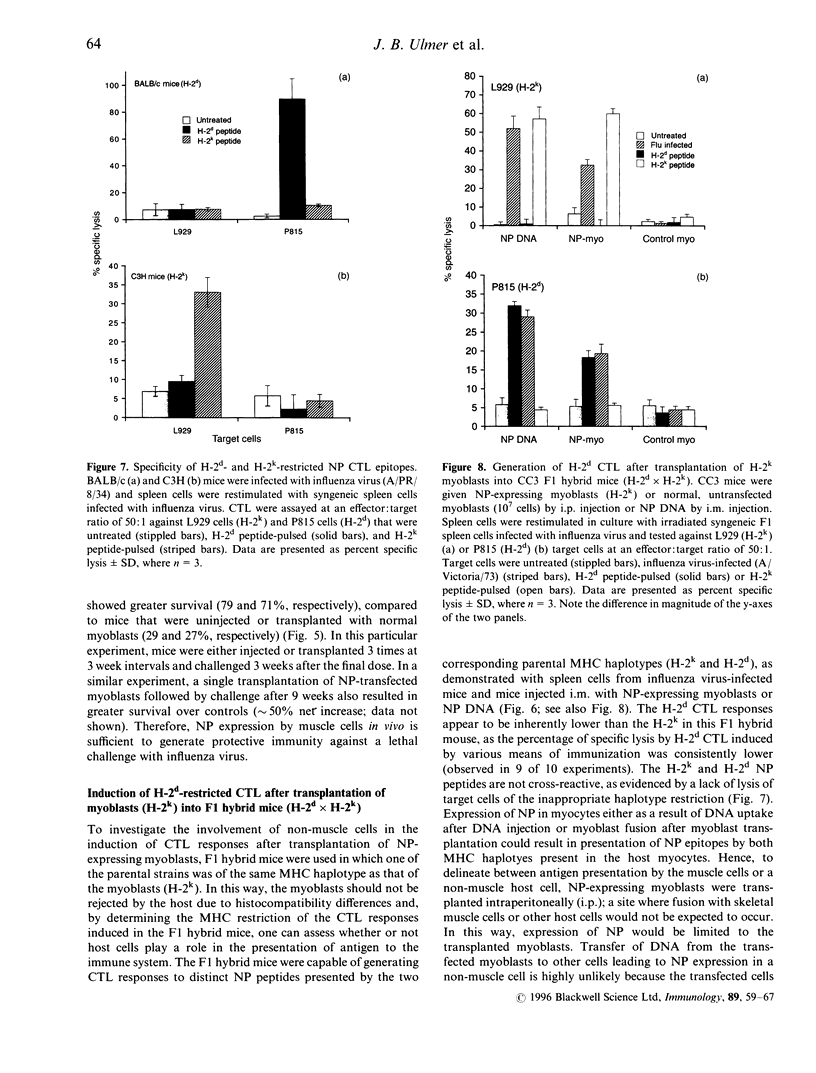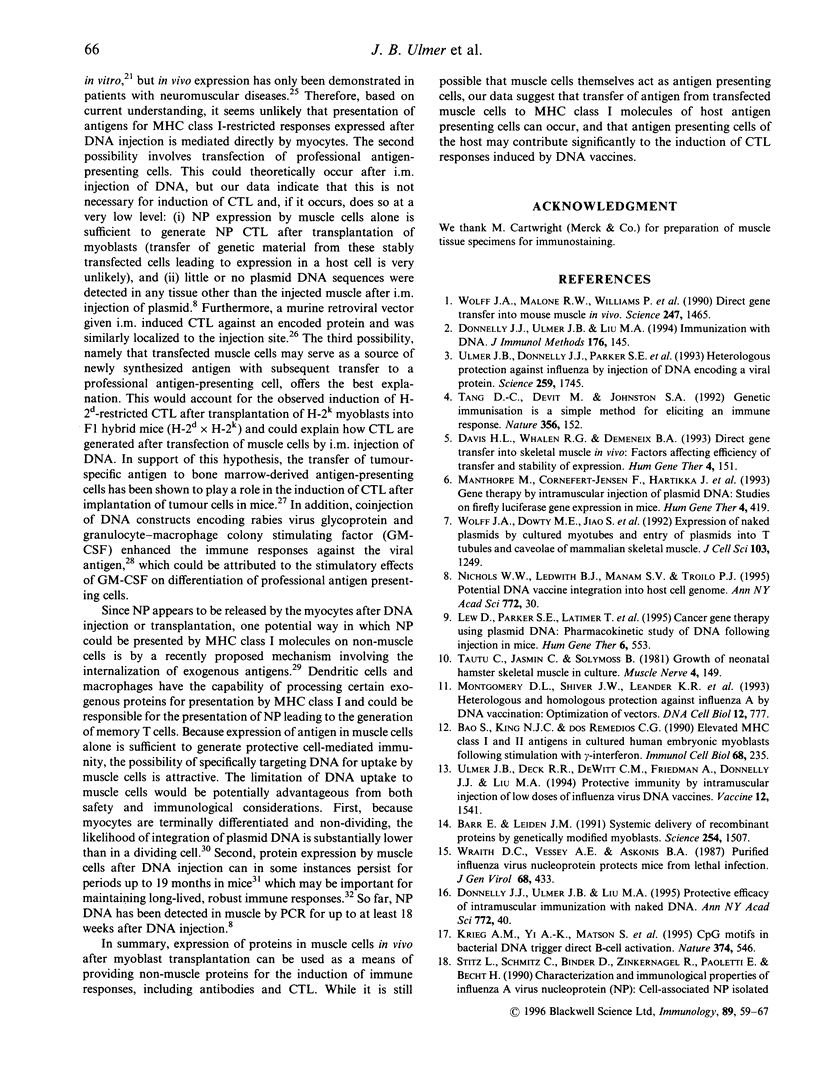Abstract
Expression of reporter genes in muscle cells has been achieved by intramuscular (i.m.) injection of plasmid DNA expression vectors. We previously demonstrated that this technique is an effective means of immunization to elicit both antibodies capable of conferring homologous protection and cell-mediated immunity leading to cross-strain protection against influenza virus challenge in mice. These results suggested that expression of viral proteins by muscle cells can result in the generation of cellular immune responses, including cytotoxic T lymphocytes (CTL). However, because DNA has the potential to be internalized and expressed by other cell types, we sought to determine whether or not induction of CTL required synthesis of antigen in non-muscle cells and if not whether transfer of antigen to antigen-presenting cells from muscle cells may be involved. In the present study we demonstrate that transplantation of nucleoprotein (NP)-transfected myoblasts into syngeneic mice led to the generation of NP-specific antibodies and CTL and cross-strain protective immunity against a lethal challenge with influenza virus. Furthermore transplantation of NP-expressing myoblasts (H-2k) intraperitoneally into F1 hybrid mice (H-2d x H-2k) elicited NPCTL restricted by the MHC haplotype of both parental strains. These results indicate that NP expression by muscle cells after transplantation was sufficient to generate protective cell-mediated immunity and that induction of the CTL response was mediated at least in part, by transfer of antigen from the transplanted muscle cells to a host cell.
Full text
PDF








Selected References
These references are in PubMed. This may not be the complete list of references from this article.
- Bao S. S., King N. J., dos Remedios C. G. Elevated MHC class I and II antigens in cultured human embryonic myoblasts following stimulation with gamma-interferon. Immunol Cell Biol. 1990 Aug;68(Pt 4):235–241. doi: 10.1038/icb.1990.33. [DOI] [PubMed] [Google Scholar]
- Barr E., Leiden J. M. Systemic delivery of recombinant proteins by genetically modified myoblasts. Science. 1991 Dec 6;254(5037):1507–1509. doi: 10.1126/science.1962212. [DOI] [PubMed] [Google Scholar]
- Boussiotis V. A., Barber D. L., Nakarai T., Freeman G. J., Gribben J. G., Bernstein G. M., D'Andrea A. D., Ritz J., Nadler L. M. Prevention of T cell anergy by signaling through the gamma c chain of the IL-2 receptor. Science. 1994 Nov 11;266(5187):1039–1042. doi: 10.1126/science.7973657. [DOI] [PubMed] [Google Scholar]
- Davis H. L., Whalen R. G., Demeneix B. A. Direct gene transfer into skeletal muscle in vivo: factors affecting efficiency of transfer and stability of expression. Hum Gene Ther. 1993 Apr;4(2):151–159. doi: 10.1089/hum.1993.4.2-151. [DOI] [PubMed] [Google Scholar]
- Donnelly J. J., Ulmer J. B., Liu M. A. Immunization with DNA. J Immunol Methods. 1994 Dec 2;176(2):145–152. doi: 10.1016/0022-1759(94)90308-5. [DOI] [PubMed] [Google Scholar]
- Goebels N., Michaelis D., Wekerle H., Hohlfeld R. Human myoblasts as antigen-presenting cells. J Immunol. 1992 Jul 15;149(2):661–667. [PubMed] [Google Scholar]
- Grabstein K. H., Eisenman J., Shanebeck K., Rauch C., Srinivasan S., Fung V., Beers C., Richardson J., Schoenborn M. A., Ahdieh M. Cloning of a T cell growth factor that interacts with the beta chain of the interleukin-2 receptor. Science. 1994 May 13;264(5161):965–968. doi: 10.1126/science.8178155. [DOI] [PubMed] [Google Scholar]
- Gray D., Matzinger P. T cell memory is short-lived in the absence of antigen. J Exp Med. 1991 Nov 1;174(5):969–974. doi: 10.1084/jem.174.5.969. [DOI] [PMC free article] [PubMed] [Google Scholar]
- Huang A. Y., Golumbek P., Ahmadzadeh M., Jaffee E., Pardoll D., Levitsky H. Role of bone marrow-derived cells in presenting MHC class I-restricted tumor antigens. Science. 1994 May 13;264(5161):961–965. doi: 10.1126/science.7513904. [DOI] [PubMed] [Google Scholar]
- Karpati G., Pouliot Y., Carpenter S. Expression of immunoreactive major histocompatibility complex products in human skeletal muscles. Ann Neurol. 1988 Jan;23(1):64–72. doi: 10.1002/ana.410230111. [DOI] [PubMed] [Google Scholar]
- Knechtle S. J., Wang J., Jiao S., Geissler E. K., Sumimoto R., Wolff J. Induction of specific tolerance by intrathymic injection of recipient muscle cells transfected with donor class I major histocompatibility complex. Transplantation. 1994 Apr 15;57(7):990–996. [PubMed] [Google Scholar]
- Krieg A. M., Yi A. K., Matson S., Waldschmidt T. J., Bishop G. A., Teasdale R., Koretzky G. A., Klinman D. M. CpG motifs in bacterial DNA trigger direct B-cell activation. Nature. 1995 Apr 6;374(6522):546–549. doi: 10.1038/374546a0. [DOI] [PubMed] [Google Scholar]
- Kündig T. M., Bachmann M. F., DiPaolo C., Simard J. J., Battegay M., Lother H., Gessner A., Kühlcke K., Ohashi P. S., Hengartner H. Fibroblasts as efficient antigen-presenting cells in lymphoid organs. Science. 1995 Jun 2;268(5215):1343–1347. doi: 10.1126/science.7761853. [DOI] [PubMed] [Google Scholar]
- Lew D., Parker S. E., Latimer T., Abai A. M., Kuwahara-Rundell A., Doh S. G., Yang Z. Y., Laface D., Gromkowski S. H., Nabel G. J. Cancer gene therapy using plasmid DNA: pharmacokinetic study of DNA following injection in mice. Hum Gene Ther. 1995 May;6(5):553–564. doi: 10.1089/hum.1995.6.5-553. [DOI] [PubMed] [Google Scholar]
- Manthorpe M., Cornefert-Jensen F., Hartikka J., Felgner J., Rundell A., Margalith M., Dwarki V. Gene therapy by intramuscular injection of plasmid DNA: studies on firefly luciferase gene expression in mice. Hum Gene Ther. 1993 Aug;4(4):419–431. doi: 10.1089/hum.1993.4.4-419. [DOI] [PubMed] [Google Scholar]
- Miller D. G., Adam M. A., Miller A. D. Gene transfer by retrovirus vectors occurs only in cells that are actively replicating at the time of infection. Mol Cell Biol. 1990 Aug;10(8):4239–4242. doi: 10.1128/mcb.10.8.4239. [DOI] [PMC free article] [PubMed] [Google Scholar]
- Montgomery D. L., Shiver J. W., Leander K. R., Perry H. C., Friedman A., Martinez D., Ulmer J. B., Donnelly J. J., Liu M. A. Heterologous and homologous protection against influenza A by DNA vaccination: optimization of DNA vectors. DNA Cell Biol. 1993 Nov;12(9):777–783. doi: 10.1089/dna.1993.12.777. [DOI] [PubMed] [Google Scholar]
- Nichols W. W., Ledwith B. J., Manam S. V., Troilo P. J. Potential DNA vaccine integration into host cell genome. Ann N Y Acad Sci. 1995 Nov 27;772:30–39. doi: 10.1111/j.1749-6632.1995.tb44729.x. [DOI] [PubMed] [Google Scholar]
- Rock K. L., Rothstein L., Gamble S., Fleischacker C. Characterization of antigen-presenting cells that present exogenous antigens in association with class I MHC molecules. J Immunol. 1993 Jan 15;150(2):438–446. [PubMed] [Google Scholar]
- Sajjadi N., Kamantigue E., Edwards W., Howard T., Jolly D., Mento S., Chada S. Recombinant retroviral vector delivered intramuscularly localizes to the site of injection in mice. Hum Gene Ther. 1994 Jun;5(6):693–699. doi: 10.1089/hum.1994.5.6-693. [DOI] [PubMed] [Google Scholar]
- Tang D. C., DeVit M., Johnston S. A. Genetic immunization is a simple method for eliciting an immune response. Nature. 1992 Mar 12;356(6365):152–154. doi: 10.1038/356152a0. [DOI] [PubMed] [Google Scholar]
- Tautu C., Jasmin G., Solymoss B. C. Growth of neonatal hamster skeletal muscle in culture. Muscle Nerve. 1981 Mar-Apr;4(2):149–154. doi: 10.1002/mus.880040212. [DOI] [PubMed] [Google Scholar]
- Ulmer J. B., Deck R. R., DeWitt C. M., Friedman A., Donnelly J. J., Liu M. A. Protective immunity by intramuscular injection of low doses of influenza virus DNA vaccines. Vaccine. 1994 Dec;12(16):1541–1544. doi: 10.1016/0264-410x(94)90081-7. [DOI] [PubMed] [Google Scholar]
- Ulmer J. B., Donnelly J. J., Parker S. E., Rhodes G. H., Felgner P. L., Dwarki V. J., Gromkowski S. H., Deck R. R., DeWitt C. M., Friedman A. Heterologous protection against influenza by injection of DNA encoding a viral protein. Science. 1993 Mar 19;259(5102):1745–1749. doi: 10.1126/science.8456302. [DOI] [PubMed] [Google Scholar]
- Warrens A. N., Zhang J. Y., Sidhu S., Watt D. J., Lombardi G., Sewry C. A., Lechler R. I. Myoblasts fail to stimulate T cells but induce tolerance. Int Immunol. 1994 Jun;6(6):847–853. doi: 10.1093/intimm/6.6.847. [DOI] [PubMed] [Google Scholar]
- Wolff J. A., Dowty M. E., Jiao S., Repetto G., Berg R. K., Ludtke J. J., Williams P., Slautterback D. B. Expression of naked plasmids by cultured myotubes and entry of plasmids into T tubules and caveolae of mammalian skeletal muscle. J Cell Sci. 1992 Dec;103(Pt 4):1249–1259. doi: 10.1242/jcs.103.4.1249. [DOI] [PubMed] [Google Scholar]
- Wolff J. A., Ludtke J. J., Acsadi G., Williams P., Jani A. Long-term persistence of plasmid DNA and foreign gene expression in mouse muscle. Hum Mol Genet. 1992 Sep;1(6):363–369. doi: 10.1093/hmg/1.6.363. [DOI] [PubMed] [Google Scholar]
- Wolff J. A., Malone R. W., Williams P., Chong W., Acsadi G., Jani A., Felgner P. L. Direct gene transfer into mouse muscle in vivo. Science. 1990 Mar 23;247(4949 Pt 1):1465–1468. doi: 10.1126/science.1690918. [DOI] [PubMed] [Google Scholar]
- Wraith D. C., Vessey A. E., Askonas B. A. Purified influenza virus nucleoprotein protects mice from lethal infection. J Gen Virol. 1987 Feb;68(Pt 2):433–440. doi: 10.1099/0022-1317-68-2-433. [DOI] [PubMed] [Google Scholar]
- Xiang Z., Ertl H. C. Manipulation of the immune response to a plasmid-encoded viral antigen by coinoculation with plasmids expressing cytokines. Immunity. 1995 Feb;2(2):129–135. doi: 10.1016/s1074-7613(95)80001-8. [DOI] [PubMed] [Google Scholar]


